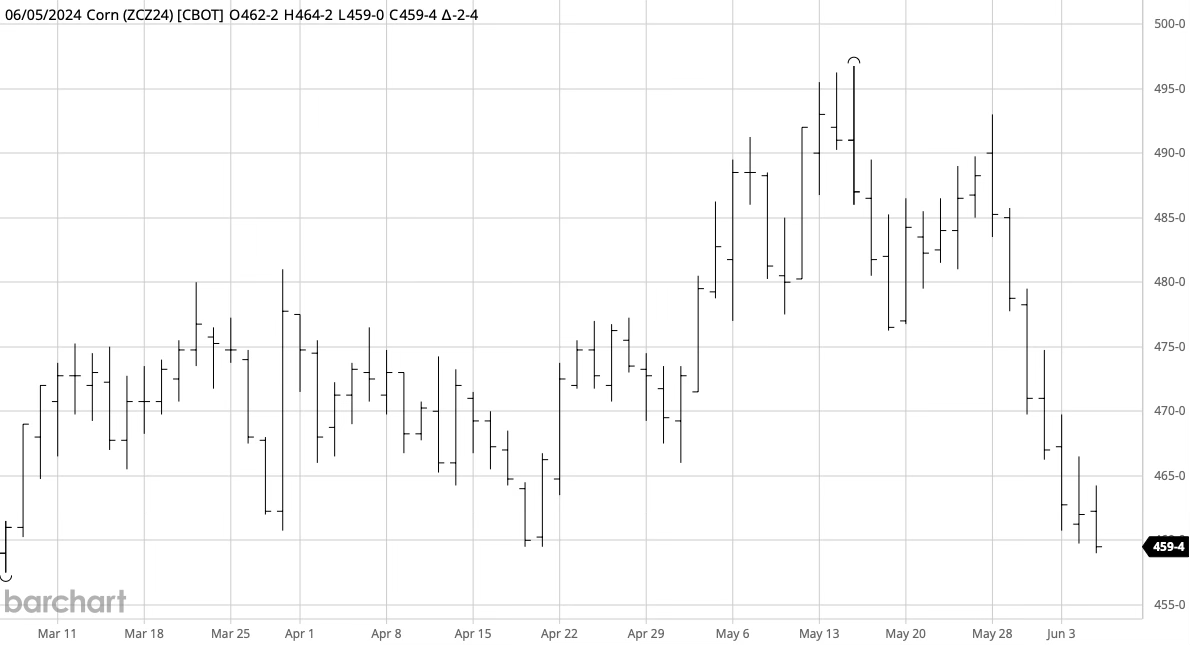We got the corn planted
As of June 3rd, planting progress still indicates trend line yields for 2024.
Many states (and farmers) worked through a wetter-than-normal late April and early May, enough that concerns grew about planting progress and the eventual impact on 2024 yields. New crop corn prices rallied from $4.60 to $4.95 between April 15th and May 15th.
During mid-May, weather patterns changed, and planting progress accelerated, resulting in prices giving back that rally in the weeks since May 15th.
Using the weather model for corn from this earlier post, I calculated the currently predicted yield by state using the most recent data available. I found two things: first, the planting rate doesn’t indicate any reason to be worried about yield this fall. Second, that while there are some differences between using the May 15 date recommended by FarmDoc and others to measure late planting, that date matters much more for Illinois, Indiana, and Iowa than others.
In the table below are projections of 2024 corn yield by state for the 10 largest corn producing states in the US. The first data column (June 3rd) is the projected yield using all of the data available as of the June 3rd, 2024 Crop Progress report, specifically, lateplanted, SepMarPrecip, and AprTemp for 2024 are used to calculate the projection, though the model is only estimated with data through 2023.
The column Jan 1st is the projection for 2024 yields by state ignoring what we know has happened so far in 2024.
2024 Yield Prospective Proj. Prod. (m bu)
State June 3rd Jan 1st se Plantings Jun 3rd Jan 1st
INDIANA 183.8 186.0 3.65 5100 948 937
ILLINOIS 197.6 199.0 3.20 10900 2168 2153
IOWA 202.9 204.0 2.76 12800 2611 2597
MINNESOTA 196.1 197.2 4.51 7900 1557 1549
MISSOURI 162.7 156.8 4.53 3500 548 569
NEBRASKA 189.8 189.5 2.26 9850 1866 1869
NORTH DAKOTA 137.6 140.0 7.20 3800 532 523
OHIO 187.2 183.2 4.08 3300 604 617
SOUTH DAKOTA 165.0 163.3 3.65 6000 979 989
WISCONSIN 177.6 178.9 3.61 3800 679 674
Total 186.4 186.7 n/a 66950 12498 12481As you can see, the differences this year between the Jan 1 and the June 3 models aren’t large, particularly when compared to the standard error of the model, which is an estimate of the variability of the prediction. In general, the only state that so far exhibit more than one standard error of difference is Missouri, though Ohio is within a hair (0.08 standard errors) of doing so. (Is it a coincidence that these are the only two states in this list I’ve lived in?)
When we add the acreage estimates from the March 31st Prospective Plantings report, and then calculate the net effect on production, we get a similar story, with very small differences. In the total bushel calculation, it is also easier to see that the changes largely cancel out, for only a total of 18m bushel greater forecast production for these 10 states.
So, to summarize, from what we know so far, we are still on track for a trend line yield in the US for corn. In future posts, I’ll run the same analysis for soybeans, and present what it means for my balance sheets for both crops.

